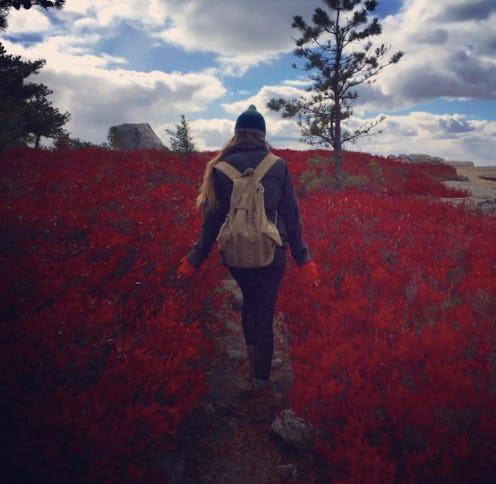Life
The Science Behind All Things Autumnal

Every year, I look forward to the fall foliage — it's the only thing that gets me through the end-of-summer sads. I plan a trip upstate for when the leaves start to turn. I'll drive around taking pictures, listening to good music. I'll turn off and go hiking and soak up the insanely vibrant colors from a majestic overlook. I definitely make a *thing* out it. Because it's fleeting. Just as you start to get used to the fiery colors surrounding you, and just before you start to take it for granted, the leaves start dying and turn to brown. The color show is over before you know it, and it will be another year before you see it again.
It struck me though, that while I'm very familiar with the fall foliage, I don't exactly know what it is. Like, what makes autumn, autumn? And why do the colors change and what exactly is going on behind those lovely leaves? I realized I had a whole lot of really basic questions questions, like why does it get colder in the fall? And why do the leaves need to die? And why did we make pumpkins the ambassadors of fall? And why does the temperature drop so quickly? And why is fall so unpredictable? And why do we get so excited about sweater weather? Be honest, you have these questions, too. I've done some research to quench our curiosity, and here's what I've found — six scientific facts that explain why autumn is autumn:
Why It Gets Cold
It's not because the Earth is farther from the sun. The Earth is actually closest to the sun in January and farthest from the sun in July. The temperature changes because the Earth's axis is tilted, and during the fall, the angle that the sun's light reaches us is more dispersed. And, because the days are shorter in the fall, the sun doesn't have as much time as it does in the summer to warm things up.
Why The Leaves Change Colors
Leaves don't actually change colors. They are naturally red, yellow, orange and purple. But during the spring and summer, they are overpowered by chlorophyll. Chlorophyll is the naturally occurring chemical which makes tree leaves green. As the sunlight declines, so does the presence of the chemical in the leaves. It fades, taking with it the overbearing green pigment, allowing the leaves to wear their natural colors.
Why Leaves Fall
Leaves in leaf-shedding trees start to produce a hormone when the exposure to sunlight starts to decrease. This hormone triggers the growth of a cell that grows between the stem and the leaf and basically forces the leaf to fall off. The reason for this is because if leaves stuck around throughout the winter, they'd freeze and die anyway. But if the tree gets rid of the leaves, they start to grow new buds that will eventually turn into leaves in the spring, once they're safe from frost. Also, leaves on the forest floor help the fallen seeds to germinate.
Why Americans Are Obsessed With Pumpkin Everything
Botanically speaking, pumpkins are no different than other squashes. Our tastebuds would probably fail a blind taste test. And yet, we're so obsessed with pumpkins. We drive far away to pick them out, only to put them in front of our homes. We drink pumpkin coffee and beer and potato chips and cookies. Studies now show that it's not the actual vegetable we're obsessed with, it's the idea of it. It represents tradition and a nod to farm life — an idea that evokes romantic imagery for many. It gives us a communal interest and brings people together: to carve pumpkins, to bake pies, to meet for a pumpkin latte. We don't even really give a hoot about the actual pumpkins.
Why We Want To Fall In Love
Despite the fact that we have Bumble and Tinder to keep us connected in the cold months, it's harder to find a mate after the fall. Biologically speaking, our desire to find a partner during the fall is simply logic. Sure, we want someone to go to the pumpkin patch with, someone go on hikes with, and someone to dress up for Halloween with, but really, our objective is to fall in love during the autumn, so that we're not alone during the winter (a concept we charmingly refer to as "cuffing season"). Science isn't all that romantic when you think about it.
Why We Live For Sweater Weather
Which came first, the joy of realizing it's cool enough to wear a sweater, or the joy of warming up under the snuggly fabric of a sweater? Apparently, we're obsessed with sweater weather because we're obsessed with comfort. The combination of cool air and a warming, cozy sweater provide a noticeable comfort that translates into happiness in the brain. Basically, sweaters are like hugs.
Enjoy the oncoming autumn bliss!
Images: Courtesy of Kaitlyn Wylde